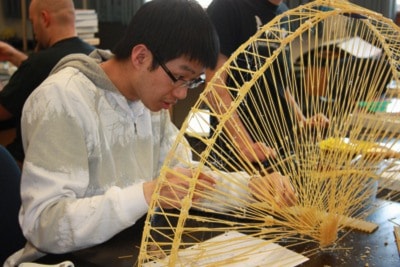A steady stream of water bears down on two bridges, increasing the load until one of them is poised to explode.
A team of designers shy away in anticipation of shards of detritus flinging in all directions. A once-proud marvel of engineering soon to be utterly destroyed.
One bridge made of rigid triangles, the other an elegant arch; both span one meter and both constructed of pasta, yes pasta, spaghetti and lasagna to be precise. But which is stronger — a truss of triangles or an arch? The answer is not so simple.
Since September, North Island College (NIC)’s first intake of engineering students have completed a full load of first-year engineering courses at NIC’s Comox Valley Campus, prior to venturing directly into second-year engineering at the University of Victoria and other universities around the country.
During this time, the students have learned chemistry, math, physics, programming and other disciplines preparing them to become expert problem solvers and inventors.
Recently, the group enjoyed the fruits of their labour in an intensive engineering design course, which crowned their first year of studies with practical skills and applications.
Over the past few weeks, NIC's first-year engineers put their minds to the test as they achieved some remarkable feats of design.
The students created detailed plans for all manner of things, from high-efficiency electric lawnmowers to pedal-powered electric generators right through to ultra-compact electric guitars.
Staying true to their Comox Valley roots, they are developing a hand tool that yanks broom plants right out of the ground.
But as the students grow, they are using less brute force and ignorance and more brilliance, finesse and innovation.
The group has modeled a radical new truss-design for a three-wheeled vehicle framed with Mother Nature’s high-performance material — bamboo.
“It's great to have a teacher like Dennis Lightfoot, who is both a master engineer and a farmer. He brings us math and physics and sprinkles dirt on them so information can grow into ideas. His converted electric tractor is an inspiring mix of old tradition mixed with cutting edge technology,” says first-year student Tomoe Yoshihara. “I'm already starting a modest career as an inventor and alternative energy consultant, so just imagine the possibilities when I graduate as a certified engineer.”
The final project in the course requires building a robot that plays a board game called Nim. The project brings together skills in mechanical design, programming and logic.
These young designers may well end up programming and building a robot that outsmarts its creators.
“Engineering design is the reward for all of our hard work since September. We are putting the textbooks down and picking up tools and robots,” says Jana Strain.
The question remains, though, what is stronger — the triangle or the arch?
With only three hours to design and create a pasta bridge, the students had to scramble. There was no time for complex calculations, so they had to go with a bit of research and basic design principles.
Trigger happy with their smoking glue guns, one team built a truss containing many triangles.
The other team noticed how pasta was much stronger when pulled rather than pushed, so they chose to construct an arch.
In the end, the hands-down winner was the arch, supporting nearly 10 times its own weight.
All it took was a little brute force and a whole lot of innovation.
For more information about NIC’s first-year engineering transfer program, visit www.nic.bc.ca or call 1-800-715-0914 and ask to speak with an advisor.
Tomoe Yoshihara is a first-year engineering student at North Island College.
